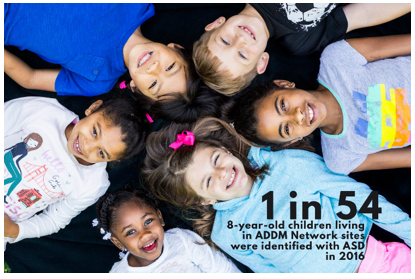New ASD prevalence numbers show gaps are closing, but more work is needed
Autism spectrum disorder (ASD) continues to affect many children and families. Services and support are critical now and as these children grow into adolescence and adulthood. More needs to be done to ensure that all children are evaluated as soon as possible after developmental concerns are identified.

For more than two decades, findings from CDC’s Autism and Developmental Disabilities Monitoring (ADDM) Network have helped us understand more about the number and characteristics of children with ASD, as well as the age at which these children are first evaluated and diagnosed.
Recent findings from the ADDM Network show that an estimated 1 in 54 8-year-old children were identified with ASD in 2016, based on tracking in 11 communities across the United States. This number is higher than estimates from our last report—1 in 59 8-year-old children were identified with ASD based on 2014 data.
To learn more about these findings, read the 2020 Community Report on Autism or the scientific reports.
Knowing how many children have ASD is just part of the picture.
The ADDM Network also helps us understand more about the characteristics of children with ASD, such as age of diagnosis and intellectual ability. These findings help us identify ways in which we have been successful in supporting children and families and highlight areas where we need improvements.
For the first time, ADDM Network data found no overall difference in the number of black children identified with ASD compared to white children.
This is good news, and highlights the important work communities are doing to have all children screened for ASD. However, the data also found that some differences between groups still exist:
- Hispanic children with ASD continue to be identified at lower rates compared to white or black children;
- Black and Hispanic children with ASD received evaluations later than white children with ASD; and
- Black and Hispanic children with ASD and intellectual disability were diagnosed at a later age than white children with ASD and intellectual disability.
These differences mean that certain groups of children may not be getting the services they need to reach their full potential. More work is needed to improve identification of children with ASD within these communities.
Communities are improving on finding children with ASD at younger ages.
ADDM Network data from 2014 found that 74% of 4-year-old children** with ASD received a developmental evaluation by 36 months of age. This increased to 84% of 4-year-old children with ASD in the 2016 group. In addition, more children who were born in 2012 received an ASD diagnosis by 4 years of age compared to children born in 2008.
Service providers, such as healthcare organizations and school systems, researchers, and policymakers can use ADDM Network findings to
- Support service planning;
- Inform policies that promote improved outcomes in health care and education;
- Guide research on risk and protective factors for ASD; and
- Promote interventions that can help children succeed.
Together, those who work with or on behalf of children—from healthcare providers to educators to community advocates—can ensure that all children with ASD are identified and connected to the services they need as early as possible.
Parents should take two important steps if they suspect their child might have ASD:
- Talk to their child’s healthcare provider about their concerns.
- Call their local Early Intervention program or school system for a free evaluation of their child.
CDC’s FREE Milestone Tracker app makes it easy for parents to track, support, and discuss their young child’s development with their child’s healthcare provider. Many children with a developmental disability are not identified until after starting school. Early intervention (before school age) can not only have a significant impact on a child’s ability to learn new skills, but also reduces the need for costly interventions over time.
The app is available in both English and Spanish. Download it for FREE in the App Store and on Google Play.
Parents should remember that it’s never too late to get help for their child, and an ASD diagnosis from a doctor is not necessary for a child to begin receiving some types of services. For more tips on what parents and others can do when there is a concern, visit CDC’s If You’re Concerned website.
More Information
Read the full scientific report:
- Prevalence of Autism Spectrum Disorder Among Children Aged 8 Years — Autism and Developmental Disabilities Monitoring Network, 11 Sites, United States, 2016
- Early Identification of Autism Spectrum Disorder Among Children Aged 4 Years — Early Autism and Developmental Disabilities Monitoring Network, Six Sites, United States, 2016
- Learn more about ASD
- Access FREE resources for parents, health professionals, childcare providers, and educators who work with children.
- Learn more about CDC’s ongoing ASD tracking system, the Autism and Developmental Disabilities Monitoring (ADDM) Network.
* The prevalence estimate of ASD among 8-year-old children represents a single point in time (2016) and is a combined estimate from 11 communities in the United States. ADDM is not a representative sample of the United States, but an in-depth look at 11 communities that make up the ADDM Network. These findings cannot be used to generalize ASD prevalence across the United States.
**Data come from the Early ADDM Network, a subset of six communities from the broader ADDM Network of 11 communities that collect information about ASD prevalence and early identification among 4-year-old children.
